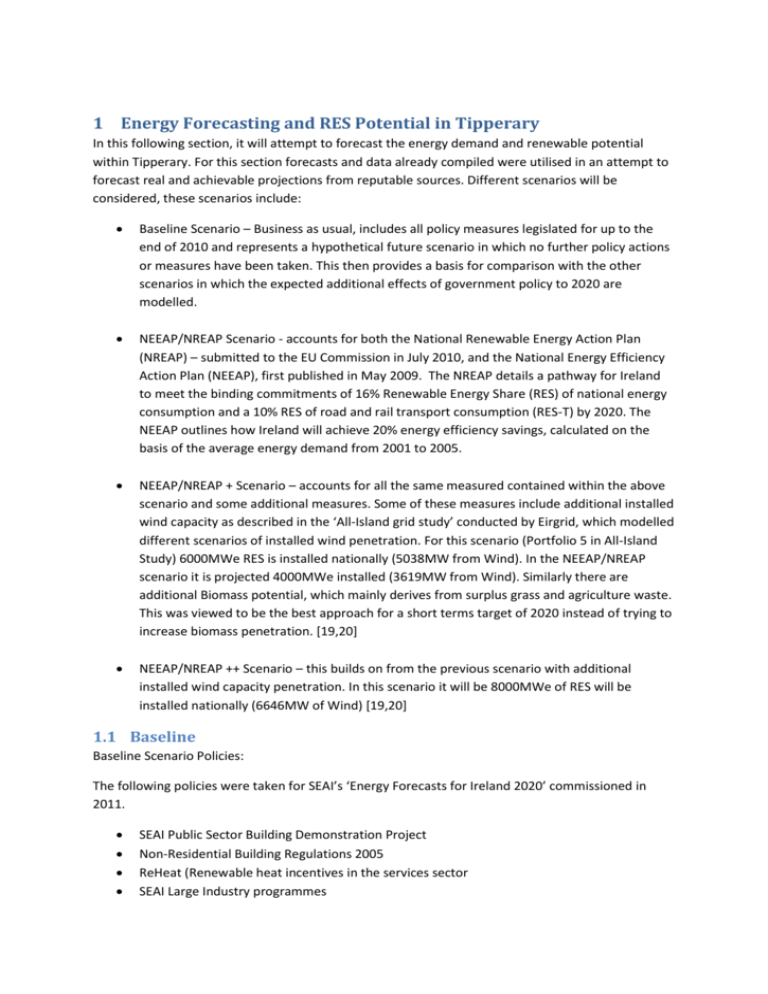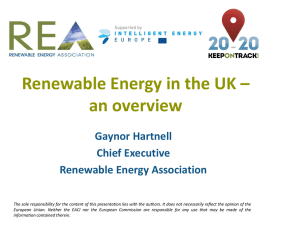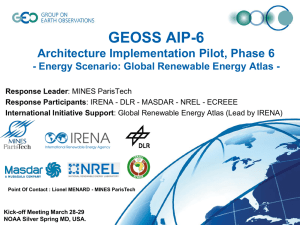Forecasting Energy Demand and Renewable Potential in Tipperary
advertisement

1 Energy Forecasting and RES Potential in Tipperary In this following section, it will attempt to forecast the energy demand and renewable potential within Tipperary. For this section forecasts and data already compiled were utilised in an attempt to forecast real and achievable projections from reputable sources. Different scenarios will be considered, these scenarios include: Baseline Scenario – Business as usual, includes all policy measures legislated for up to the end of 2010 and represents a hypothetical future scenario in which no further policy actions or measures have been taken. This then provides a basis for comparison with the other scenarios in which the expected additional effects of government policy to 2020 are modelled. NEEAP/NREAP Scenario - accounts for both the National Renewable Energy Action Plan (NREAP) – submitted to the EU Commission in July 2010, and the National Energy Efficiency Action Plan (NEEAP), first published in May 2009. The NREAP details a pathway for Ireland to meet the binding commitments of 16% Renewable Energy Share (RES) of national energy consumption and a 10% RES of road and rail transport consumption (RES-T) by 2020. The NEEAP outlines how Ireland will achieve 20% energy efficiency savings, calculated on the basis of the average energy demand from 2001 to 2005. NEEAP/NREAP + Scenario – accounts for all the same measured contained within the above scenario and some additional measures. Some of these measures include additional installed wind capacity as described in the ‘All-Island grid study’ conducted by Eirgrid, which modelled different scenarios of installed wind penetration. For this scenario (Portfolio 5 in All-Island Study) 6000MWe RES is installed nationally (5038MW from Wind). In the NEEAP/NREAP scenario it is projected 4000MWe installed (3619MW from Wind). Similarly there are additional Biomass potential, which mainly derives from surplus grass and agriculture waste. This was viewed to be the best approach for a short terms target of 2020 instead of trying to increase biomass penetration. [19,20] NEEAP/NREAP ++ Scenario – this builds on from the previous scenario with additional installed wind capacity penetration. In this scenario it will be 8000MWe of RES will be installed nationally (6646MW of Wind) [19,20] 1.1 Baseline Baseline Scenario Policies: The following policies were taken for SEAI’s ‘Energy Forecasts for Ireland 2020’ commissioned in 2011. SEAI Public Sector Building Demonstration Project Non-Residential Building Regulations 2005 ReHeat (Renewable heat incentives in the services sector SEAI Large Industry programmes Residential Building Regulations 2002 SEAI Warmer Homes Scheme SEAI Greener Homes Scheme (efficiency gains) Green Public Procurement (via the Accelerated Capital Allowance Scheme (ACA)) Supports for Exemplar Energy Efficiency Projects (SEEEP) and Energy Efficiency Retrofit Fund (EERF) public and commercial sector grants SEAI Small Business (SME) Supports Accelerated Capital Allowance Scheme (services sector) Residential Building Regulations 2008 Efficient Boiler Standards Domestic lighting efficiency gains (Eco-Design Directive) SEAI Home Energy Saving scheme VRT/motor tax changes Improved economy of private-car fleet (by EU regulation) Aviation efficiency Assumptions on the supply side relating to electricity, transport and heat renewable energy production represent achievements to date and actions committed to previously, of which the impact is assumed to be already implicit in the Baseline forecasted trends. These achievements are: Renewable electricity generation capacity is based on those units that have secured a gridconnection agreement and can avail of the Renewable Energy Feed-In Tariff (REFIT). This amounts to a total renewable electricity capacity of 2,840 MW by 2020 as compared to around 1,500 MW capacity at the end of 2010. The Biofuels Obligation Act 2010 sets renewable energy usage in the transport sector at 3% (4% by volume) of all energy consumption in the sector. The 2008 Building Regulations specify that at least 10 kWh/m per annum of the heat requirements of a residential dwelling must come from renewable sources. It should be noted that the Baseline scenario does not include the impact of further delivery of renewable electricity as expected through the Gate 3 process. This is incorporated and further discussed in subsequent scenarios. [25] 1.2 NEEAP/NREAP Scenario This scenario is based on the details published in both the National Energy Efficiency Action Plan (NEEAP) and the National Renewable Energy Action Plan (NREAP). These have been submitted to the EU Commission and represent Ireland’s strategy to meet energy efficiency and renewable energy obligations at national and EU level. While they are updated overdue/due as of writing of this document they have not being published yet, therefore the data from the NEEAP (2009) and NREAP (2010) will be used NEEARP/NREAP Scenario Policies: Energy Efficiency In addition to the energy efficiency measures applied in the Baseline, the following measures are incorporated in the NEEAP/NREAP scenarios to model the expected impact of achieving Ireland’s national 20% energy savings target for 2020. These measures are applied in the modelling ahead of application of the supply-side measures: SEAI Public Sector Programme Public transport efficiency Better Energy Workplaces (services sector) Residential Building Regulations 2011 Nearly zero energy dwellings (a further revision to the Residential Building Regulations in 2016) Building Regulations 2012 – Buildings other than dwellings Smart meter roll-out Better Energy Homes Electric vehicle deployment More efficient road traffic movements (Source SEAI: ENERGY FORECASTS FOR IRELAND TO 2020) Renewable Energy The NEEAP/NREAP scenario applies the methodology used in the production of Ireland’s NREAP. The NREAP outlines the minimum response required from the various policy measures in order to achieve the Renewable Energy Directive (28/EC/2009) obligations of: 16% of total energy consumption from renewable sources by 2020 (RES-16%) 10% of consumption in the transport sector from renewable sources by 2020 (RES-10% The White Paper of 2007 and subsequent government announcements outline renewable targets for 2020 for each energy use mode – a 40% share of renewable energy in electricity (RES-E), a 10% share of renewable energy in transport (RES-T) and a 12% share of renewable energy in heat (RES-H). These modal targets are used as a starting point for modelling the RES 16% in the NEEAP/NREAP scenario on the following basis: 1. If the combination of White Paper targets results in a shortfall below RES 16%, RES-E is increased. This reflects the potential available for renewable electricity generation. 2. If the combination of the White Paper targets results in the RES 16% being surpassed, RES-H is reduced. This recognises the documented challenges of stimulating renewable heat use. The NREAP points to a range of policy actions required to achieve the outlined obligations. These are used as the basis for modelling the NEEAP/NREAP scenario. RES-E The Renewable Energy Feed-In Tariff (REFIT) is the main policy instrument used to support the expansion of renewable electricity capacity. These tariffs, in conjunction with other supports relating to infrastructure, RD&D, etc. are designed to deliver: An expansion of biomass electricity-generating capacity to 270 MW through the implementation of co-firing plans in Edenderry power station (35 MW), the construction of two waste-to-energy units (44 MW), and the continued development of landfill-gas electricity generation (44 MW) and biomass CHP (150 MW). Construction of at least 75 MW of wave energy. An expansion of both onshore and offshore wind capacity, supported by the Gate 3 process, and the rollout of the transmission network upgrade plans RES-T The Biofuels Obligation Act 2010 and the rollout of the Electric Vehicles (EVs) support measures, to help achieve the target of 10% of road vehicles being electric by 2020, and drive the renewable energy usage in transport. The biofuel obligation is designed so it can be adjusted upwards as required to meet the target. RES-H The recently approved REFIT tariffs for biomass CHP drive the use of renewable heat in industrial and commercial applications. Part L of the 2008 Building Regulations requires new residential buildings to install renewable heating technology. [19,20] 1.3 NEEAP/NREAP + Scenario As mentioned previously this scenario is in addition to the NEEAP/NREAP scenario. The major difference is as follows: Wind Using Eirgrid’s All-Island grid Study Portfolio 5 scenario, additional wind (236MW) is installed in Tipperary, half is installed 2015 and half in 2018. Biomass Solar Using a research paper ‘A biofuel strategy for Ireland with an emphasis on production of biomethane and minimization of land-take’ by Anoop Singh, Beatrice M. Smyth, Jerry D. Murphy (2010) which investigates the smallest land take to achieve biofuel targets. This report concludes that excess grass with Anaerobic Digestion within the country could help to achieve bioenergy targets. For Tipperary it is estimates that an additional 20.75ktoe could be utilised in this fashion. For Solar in this scenario it is assumed a high solar uptake, given the positive feedback solar thermal is now receiving and the RES requirement within the building regulations. PV price per m2 is also falling dramatically and it is felt a technology which could gather momentum on a domestic scale. For Solar PV and Solar Thermal we have assumed that 60% of the houses within Tipperary have either south, south west or south east facing roof space. It is then assumed that 60% of those could afford it and that 70% of those would be interested I.e. 25% of houses. It is then assumed that 6m2 of thermal and 9m2 of PV could be installed. This would give thermal 1.8 Ktoe and PV 1.4 ktoe in Tipperary. [19,20, 23] 1.4 NEEAP/NREAP ++ Scenario This scenario is a continuation of the NEEAP/NREAP + scenario. The only different with this and the previous is increased installed wind capacity based on portfolio 6 of the All-Island Grid study. This involves an additional 291MW, again half in two blocks in 2015 and 2018. 2 Results The following sections outline the energy demand currently and in the baseline line scenario and the NEEAP/NREAP scenario. The additional scenarios have the same energy demand forecast as the NEEAP/NREAP scenario as those two scenarios are more focused on RES generation than energy efficiency measures. The RES generation by technology and mode of application will also be shown for all scenarios. 2.1.1 Energy Demands 500 450 400 TFC (ktoe) 350 Agriculture 300 Commercial 250 Residential 200 Transport 150 Industry 100 50 0 2011 Baseline NEEAP/NREAP Figure 2-1 Tipperary Energy Demand TFC (Economic Sectors) [19-25] Industry Transport Residential Commercial Agriculture Total 2011 share 20.5% 38.3% 26.4% 12.4% 2.5% 100.0% Baseline Change to 2011 4.5% 19.5% 12.5% 15.9% 17.6% 14.1% NEEAP Change to 2011 3.3% 29.4% -10.0% -2.8% 17.6% 9.4% NEEAP to Baseline -1.2% 8.2% -20.0% -16.2% 0.0% -4.1% Table 2-1 Energy Demand Scenarios [19-25] In 2011, the main contributor to energy demand was transport (38%), followed by residential (26%), industry (20.5%), services (12.4%) and agriculture (2.5%). Transport is set to still increase in both 2020 scenarios Residential and commercial are set increase within the baseline scenario by 12.5% and 16% respectively but within the NEEAP scenario they are set to decrease by 10 and 3% respectively. Overall energy demand is set to increase by 9% in the NEEAP/NREAP scenario compared to 14% in the baseline scenario. 2.1.2 Industry sector accounts for 20.5% of TFC in 2011, with demand peaking in the sector in 2006, with RES accounting for 22% of TFC due to Medite. Accelerated Capital Allowance Scheme and large industrial energy network helping to attribute to these savings. A projected 3.3% increase in energy use by 2020 within the NEEAP scenario and 4.5% within the baseline scenario. Residential sector currently accounted for 26.4%. The housing stock in Tipperary increased from 38,036 in 1990 to 58,275 in 2011. An expected decrease in energy use in all fuels is expected except for renewables as they are expected to increase. Due to improved building regulations reducing energy demand and increasing RES use within the domestic setting. Agriculture high percentage change is more a reflection on its low base. Renewable Generation 400 350 GFC(Ktoe) 300 250 200 Transport 150 Heat 100 Electricity 50 0 Figure 2-2 RES mode of application (All Scenarios) [19-25] Target to achieve: 40% of electricity consumption from renewable energy by 2020 (RES-E 40%) 10% of transport consumption from renewable energy by 2020 (RES-T 10%) 12% of thermal consumption from renewable energy by 2020 (RES-H 12%) Current Ktoe Baseline %RES ktoe NEEAP/ NREAP NEEAP/ NREAP + NEEAP/ NREAP ++ %RES Ktoe % RES Ktoe % RES Ktoe % RES Electricity 21 30% 36 45% 135 171% 193 245% 254 323% Heat 25 15% 26 14% 28 18% 56 36% 64 36% Transport Total 2 52 1% 13% 7 75 4% 17% 23 195 12% 46% 25 282 13% 66% 25 344 13% 81% Table 2-2 RES Generation (All Scenarios) [19-25] Baseline Based on the Baseline scenario Tipperary would achieve its targets on electricity and heat but not in transport. Heat would still be heavily dependent on Medite and its contribution to RES heat. Meanwhile the national RES % of target achieved would be 27% for electricity, 5.4% for heat and 2.4% for transport, there would still be some way off achieving the targets. NEEAP/NREAP The major growth area within Tipperary within NEEAP in electricity, with a 543% increase in RES electricity from 2011, in fact within this scenario Tipperary would become an exporter of electricity as it produces over 71% more that is required in TFC. Transport also grow, this is in line with national growth rate and surpasses transport targets. Heat, namely biomass, did not improve this is mainly due to Medite’s contribution is left constant, which already for the region is over-inflated in comparison to the national. NEEAP/NREAP ++ Within this scenario over 145% of the electricity in Tipperary would be exported to outside the region. Heat within this scenario excluding Medite would surpass targets. NEEAP/NREAP ++ Within this scenario over 223% of the electricity in Tipperary would be exported to outside the region. 400 350 GFC (Ktoe) 300 250 Hydro Wind 200 Biomass & RES Waste 150 Liquid Biofuels 100 Solar Geothermal 50 0 Figure 2-3 RES Generation by Technology [19-25] Current Hydro Wind Biomass & RES Waste Liquid Biofuels Solar Geothermal Total Baseline NEEAP/ NREAP NEEAP/ NREAP + NEEAP/ NREAP ++ 0.07 21.3 0.08 36.0 0.07 135 0.09 193 0.09 254.37 24.5 1.6 0.2 0.6 51.9 24.5 7.3 0.6 0.6 74.9 24.5 23.4 1.3 2.3 195.0 50.6 25.0 3.1 2.3 282.36 50.56 24.99 3.13 2.27 343.73 Table 2-3 RES Generation Values (All technologies) [19-25] Biofuels Biofuels follow the national trend and is based on land area of Tipperary. Solar & Geothermal Again follow national trends and are proportionally sized down to Tipperary level based on number of houses. Wind Shown in Figure 2-4 is the development of the wind sector in Tipperary. As mentioned previously the wind energy generated is based on a set of assumptions, stated in Section 3. o Further from these assumptions capacity factors are also needed in judging the wind energy generated. This is based on national level of wind installed capacity penetration in the grid. Based on Eirgrid’s All-Island Grid Study report, these capacity factors are shown in Error! Reference source not found.. We can see that wind energy in Tipperary will surpass electricity demand in the country by 2015, when the first block of wind farms will be installed in the county as part of gate 31. 160 140 Wind Energy (Ktoe) 120 700 100% of Electricity in Tipperary consumed is covered by Wind Energy 600 500 100 400 80 300 60 200 40 Installed Capacity (mW) Wind Energy Generate d (Ktoe) Installed Cpacity (MW) 100 20 0 0 Figure 2-4 Wind Sector Progression in Tipperary [20,21] 1 Eirgrid’s Gate 3 schedule of firm access (http://www.eirgrid.com/media/Gate%203%20ITC%20Results%202010-2023.pdf) has the two major block of wind farm connections in 2015 and 2018






